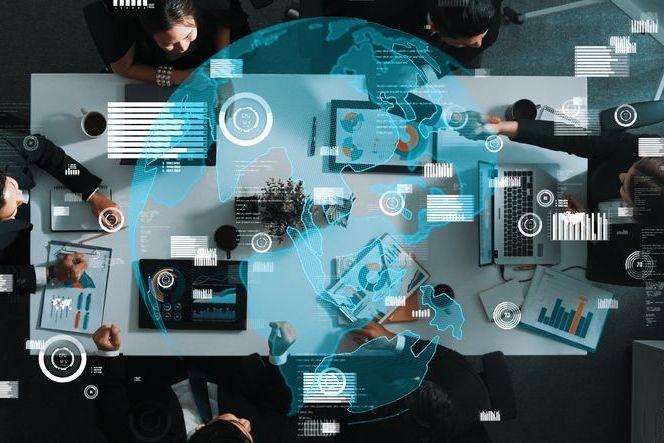
Artificial Intelligence (AI) is a powerful force reshaping industries worldwide. From automating customer service to transforming logistics and financial analysis, AI is changing how work gets done. While businesses adopt those tools to improve efficiency, they often neglect the side effects—like staff, worried by AI taking over jobs, showing signs of mental health issues.
This HR Day is the right time to address how proactive, ethical leadership from HR can help to manage the human impact of AI-driven anxiety on blue- and white-collar jobs alike. In this article, we’ll discuss the impact of AI and present tips for HR teams to address this situation.
Is AI taking over jobs?
The quick answer is yes, AI is taking over jobs. However, analysts still debate how quick or profound this transformation will be. In any case, it’s agreed that tools powered by machine learning and natural language processing are already reducing or changing the need for human input across industries—from bookkeeping and paralegal support to content generation, IT troubleshooting, customer service, and logistics.
As AI becomes more sophisticated, organizations are rethinking team structures, reassigning tasks, and, in many cases, reducing headcount. Those changes impact blue- and white-collar workers everywhere, but experts consider office jobs more at risk. The more reliant on repetitive tasks or structured decision-making the job is, the more subject it is to automation.
Expert insight:
31% of business leaders expect AI to lead to job cuts of at least 3% in the next three years.Source: McKinsey Global Survey on AI, 2025
What jobs is AI taking over?
According to specialists, certain desk jobs (such as Financial Analyst and Data Processor) are more at risk of being taken over by AI or seeing decreased demand and relevance. Truck drivers, factory workers, and customer care representatives are other roles where AI poses some kind of threat. Here are ten jobs often cited as being at risk due to the rise of AI:
- Accountants: AI-driven software automates bookkeeping, tax preparation, and financial reporting, minimizing the need for manual input and making many accounting functions faster, cheaper, and less reliant on humans.
- Cashiers: Self-checkout systems and AI-powered kiosks are automating point-of-sale transactions, reducing the need for human cashiers and streamlining operations with fewer errors and lower labour costs.
- Customer Service Representatives: Chatbots and voice AI handle routine inquiries, complaints, and transactions through cost-efficient 24/7 operations, cutting the need for large human support teams.
- Data Processors: AI systems extract, organize, and process data rapidly and accurately. Automating tasks that traditionally required manual input reduces the need for data entry roles.
- Diagnostic Technicians: AI can analyze medical images and identify patterns and abnormalities faster than humans, potentially reducing the need for radiologists and specialists in routine diagnostic interpretation.
- Factory Workers: Advanced robotics and AI-driven automation perform repetitive manufacturing tasks efficiently and accurately, reducing reliance on human labour and drastically increasing productivity.
- Financial Analysts: AI can process vast datasets, identify trends, and generate investment insights more efficiently than humans, reducing demand for traditional analyst roles.
- Journalists and Content Writers: AI tools like language models can generate articles, summaries, and marketing copy at scale, threatening traditional writing roles by delivering faster content output at lower cost.
- Software Engineers: AI-assisted coding tools generate, debug, and optimize code with minimal input, reducing the demand for junior developers and leaving engineers with supervision and high-level architecture roles.
- Truck Drivers: Self-driving vehicles and AI-powered logistics systems threaten jobs in trucking, delivery, and ride-hailing by enabling safer, more efficient, and lower-cost transportation.
Expert Insight:
In Canada, up to 90% of workers with a bachelor’s degree or higher are in jobs that could be highly exposed to AI-related transformation.
Source: Statistics Canada, 2024
How is AI impacting workers?
AI’s rapid rise is creating deep uncertainty in the workforce, potentially affecting mental health. According to an American Psychological Association survey, 38% of US workers worry that AI might make some or all of their duties obsolete in the future. Furthermore, 64% of those workers reported typically feeling tense or stressed during the workday.
This uncertainty generates a psychological toll that HR and leadership shouldn’t underestimate. Workers feeling left behind by AI may experience impostor syndrome, performance anxiety, and employee burnout. Even individuals not directly at risk may feel pressure to reskill or prove their value, fueling impostor syndrome and chronic stress.
Without the proper support, the emotional cost and human impact of AI can damage employee engagement, morale, productivity, and mental health.
How can HR support employees with the rise of AI?
As AI redefines roles, HR teams sit at the intersection of technological innovation and human care. It’s a position that demands leadership integrity every step of the way. That means communicating honestly about potential job changes or layoffs, offering clear reskilling paths, and never forgetting that there are people behind those productivity metrics.
During such uncertain times, HR, more than enforcing change, must lead with purpose, preserve trust, and prioritize employee well-being. To achieve this, it’s crucial to communicate clearly and show empathy. By putting people at the center of AI transitions, HR will help create a more stable, supportive space while demonstrating an ethical mindset.
Tips for HR teams to address AI in the workplace
How do you translate the ideal of ethical leadership into action? Here are a few tips for HR to lead teams through the AI transformation with empathy and professionalism:
- Communicate transparently and early: Keep employees informed about AI-related changes, including potential job restructuring or layoffs. Honest, timely communication builds trust and prevents misinformation from fueling anxiety.
- Acknowledge the struggle: Recognize the stress and uncertainty AI transitions can create. Offer mental health resources, encourage open conversations, and foster a workplace culture where employees feel safe discussing concerns.
- Offer reskilling and upskilling opportunities: Offer training, certifications, and mentorships to employees to adapt to AI. Focus on future-ready skills that complement AI, such as critical thinking, emotional intelligence, and creative problem-solving.
- Involve employees in the AI rollout process: When implementing AI tools, include staff in pilot programs or feedback sessions. Giving employees a voice in how AI is integrated builds buy-in, eases concerns, and encourages smoother adoption.
How is AI taking over jobs? Key takeaways
AI is changing the game, but how we play it is still up to us. As roles evolve, teams change, and stress levels rise when people see AI taking over jobs, HR teams must put ethics first.
Communicating clearly and acknowledging the challenges while building trust, enables HR teams to develop a work culture that weathers change with resilience and care. HR Day is the perfect time to show that you prioritize people over processes. Leading with ethics should be the foundation for a workplace where innovation and humanity grow side by side.If you’re looking for extra support for your staff, Careerminds is here to help. If things turn for the worse and your company opts to downsize, our outplacement services will provide individuals with tailored coaching and other resources to navigate this new reality with less anxiety. Contact our experts and learn more about the Careerminds approach to outplacement.
In need of outplacement assistance?
At Careerminds, we care about people first. That’s why we offer personalized talent management solutions for every level at lower costs, globally.




